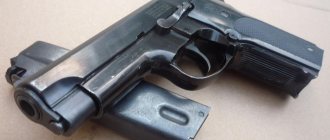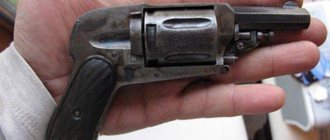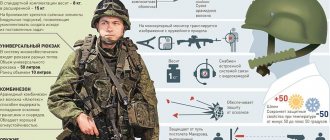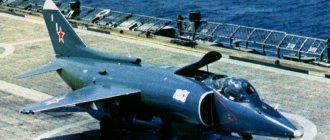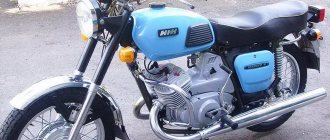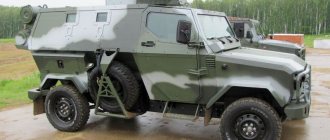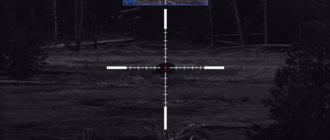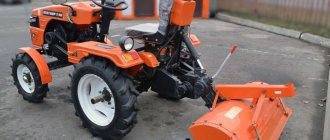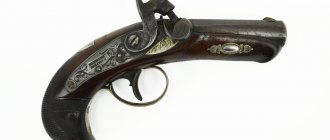A revolver (from the English word revolve - to rotate) is an individual multi-charged non-automatic small arms with a rotating drum, in which there are chambers (sockets), which are at the same time containers for steam thrones and chambers for the barrel. The rotation of the drum is carried out by the shooter when pressing the trigger or trigger.
Based on the design of the trigger mechanisms, revolvers are divided into single-action, double-action and self-cocking revolvers. Single-action revolvers allow you to fire each shot only after pre-cocking the hammer. In addition, double-action revolvers also allow self-cocking firing.
Self-cocking firing is carried out without first cocking the hammer by pressing the trigger. Some revolvers have a hammer hidden inside and therefore can only fire self-cocking.
Revolver Webley and Scott Mk VI
Without a doubt, the Mk VI was the most common and famous model. This revolver first appeared in 1915 and was used until 1930. It was in service with the British Army and was also widely used by Commonwealth troops and police. When the trigger is pulled, the cylinder is released from the stopper and rotates, placing a new cartridge in front of the barrel, and the hammer is cocked. When the trigger is further held pressed, the trigger moves forward under the action of the mainspring, and its ...
Read more
Revolver. Model 1895 revolver
Initially, the revolver was proposed by Leon Nagan, who was counting on a very profitable order, bearing in mind the experience of his predecessors. However, the Russian military department decided to start its own production of the revolver. In the Russian Empire, revolvers of the Nagant system were initially produced in Tula of two types - self-cocking, when all seven bullets could be fired one after another, and non-self-cocking - soldier, when after each shot it was necessary to cock the trigger mechanism.
It was believed that a soldier did not need a rapid-fire weapon and would only lead to a large consumption of ammunition. Musicians, artillerymen and those who were not entitled to the Three-Ruler had non-self-cocking revolvers. The advantage of the 1895 model revolver is that, despite its small caliber and size, it is a fairly powerful weapon. This is achieved due to the fact that when fired, the drum moves onto the barrel and energy loss is minimized. On the other hand, shooting requires quite a lot of physical strength from the shooter. Even an adult needs to have a very strong hand in order to accurately fire all 7 bullets one after another. Children and teenagers can only shoot with such weapons in movies about “elusive avengers.” The main disadvantage of the revolver is the reload time. It is necessary to extend the cleaning rod, open the door and extract all seven cartridges one by one. And then insert seven new cartridges, one at a time.
The first combat use of this weapon was noted during the campaign of Russian troops in China in 1900, when the lieutenant of the Siberian riflemen Stankevich, during the capture of the Taku forts, killed several ihetuans with a revolver. In the Red Army, the revolver was kept for a long time by command staff and tankers, for whom the TT pistol was inconvenient due to the movable barrel. In 1941, on the basis of this revolver, revolver guns were produced in Tula, intended for arming partisans.
Samples of such guns exist, but not a single case of their combat use during the Great Patriotic War has yet been found in documents. In the USSR, the revolver was produced at the Tula and Izhevsk factories until 1945. In the post-war period, the revolver was in service with the police and various security agencies, and until the recent past, the revolver could still be seen among collectors in Belarus. The total production of the 1895 model revolver exceeds 2 million units.
Gasser revolver
A large Austrian company was founded in 1862 by Leopold Gasser, who patented this revolver in 1870. After the death of L. Gasser in 1871, his son Johann succeeded him, who continued the mass production of this and similar revolvers until the end of the 19th century. Gasser revolvers were in service with the Austro-Hungarian army and sold well in Austria-Hungary and the Balkan Peninsula. This weapon, like other Gasser revolvers, has a split frame. Its design is very reminiscent of the early Colt, except...
Read more
Montenegrin Gasser
The term "Montenegrin Gasser" is used to describe several types of weapons, rather than just a single example. The revolver shown in the photograph has a one-piece frame, but in all other respects it is practically indistinguishable from the Gasser revolver. Some of these revolvers are flip-barrel, with a perforated extractor plate at the rear of the cylinder; others have a detachable frame; and some have a single-action trigger mechanism. Often these revolvers are richly decorated. They say that at the end of the 19th century...
Read more
Russian Smith-Wesson revolvers
The revolver is a popular weapon, known to everyone in our country, young and old, and is one of the most successful (in its class) models of small arms. It was this type of short-barreled firearm that made a truly revolutionary breakthrough in the arms industry in the middle of the 19th century. All the previous development of short-barreled weapons by this time had formed two main trends in the creation of new types of multi-shot weapons, which followed the development of both multi-barreled pistols and single-barreled revolvers. It was the revolvers that became the first examples of magazine weapons.
4.5-linear (11.43 mm) Galan revolver mod.
1870 Revolvers did not immediately acquire their final, characteristic features. This required several decades of hard work by designers, process engineers and gunsmiths. The completion of the industrial revolution in Western Europe by 1860-1870 made it possible to provide a production, scientific and technical base for the implementation of many ideas that previously seemed simply impracticable. Achievements of scientific and technological progress in practice literally upended the very foundation of the most advanced industry - weapons production. A change in weapon manufacturing technology and its transfer to a broad industrial basis made it possible to carry out a genuine revolution in small arms, which most directly influenced the emergence of rapid-fire breech-loading weapons.
Simultaneously with the improvement of repeating rifles as the main types of military weapons, revolvers were also improved. This was facilitated by the creation of a unitary cartridge with a metal sleeve. By the 1870s, revolvers had almost completely replaced outdated models of single-shot capsule pistols from circulation.
Revolvers, whose name comes from the Latin word “Revolvo” (to rotate), are single-barreled, multi-shot personal defense weapons designed to be fired with one hand. Their main difference from pistols is a rotating drum, in the chambers of which charges or cartridges are placed. The drum, rotating around its axis, combines chambers (with a capacity of 5-6 rounds), which serve as a chamber, with a stationary barrel. The drum turns are performed mechanically, using the muscular strength of the shooter. The main advantage of revolvers as self-defense weapons was their constant readiness to open fire and high rate of fire, compared to previous models of short-barreled weapons. Military-style revolvers, often very large in size and weight, chambered for powerful medium- and large-caliber cartridges, saw significant development in the mid-19th century. The main requirement for this weapon was the strong stopping effect of the bullet, not only when shooting at a person, but also, which was important in those days, when shooting at a horse. With black powder and lead bullets in use at that time, revolvers of 10-12 mm caliber, designed for unitary central ignition cartridges, were considered the most suitable for this purpose.
During the years of the Civil War in 1861-1864 in the United States of America (as the United States of America was then called), this rapid-fire repeating weapon became really in great demand. Its high combat and performance characteristics led to the fact that in the United States many gunsmiths began handicraft production of revolvers. Along with their own production, both warring parties practiced extensive purchases of these weapons in Europe, which served as one of the motivations for extensive work on creating new designs of revolvers. The success of Colt revolvers led to many imitations in America and Europe.
By this time, the practical use of these weapons determined the areas of their use. Four main types of revolvers were developed: 1. Military models included short-barreled weapons of 9-13 mm caliber, weighing about 1 kg, designed to use powerful cartridges. 2. Police models of revolvers, as a rule, had a caliber of 7–9 mm, with smaller weight-dimensional characteristics and weaker cartridges. Their weight, as a rule, did not exceed 0.9 kg. They included both models specially created for these purposes, as well as some military and civilian samples. 3. The category of “civilian” weapons included revolvers 5–12 (or more) mm, weighing from 0.3 to 1 kg. These weapons of random designs and a wide variety of calibers, as a rule, were distinguished by extremely low combat qualities due to their cheapness. 4. Sports-purpose and training revolvers were intended for sports purposes and marksmanship training. Long barrels, good balancing and more advanced sights provided them with high accuracy in combat.
By the 1860s, revolvers had replaced outdated muzzle-loading pistols almost everywhere, successfully replacing them in such an important area of small arms circulation as personal self-defense, and their main advantage, compared to previous models of short-barreled weapons, was their constant readiness to open fire and high rate of fire. After firing from a smoothbore pistol, the shooter became unarmed; having a revolver, he could continue shooting until all the cartridges in the drum were completely used up. To have at the ready, instead of one or two pistol shots, five or six revolver shots, was in many cases a great advantage. Therefore, despite the significantly higher cost of revolvers compared to a muzzle-loading pistol, almost all states began hasty re-equipment with new weapons.
Smith-Wesson revolver cartridges .45, .44, .38 caliber
Russia has not escaped new trends. While revolvers of the Colt, Remington, Lefoshe and many others systems became widespread abroad, the Russian army continued to be armed with 17.5-mm single-barrel muzzle-loading percussion-capsule pistols of the 1854 model: the soldier’s model was smooth-bore, the officer’s model was smooth-bore. with a rifled barrel, which had low accuracy and low rate of fire. Due to the low combat qualities of this weapon, Russian officers were reluctant to use it, while in the West they were already using the latest revolvers at that time.
The Crimean War once again convincingly proved that the Russian army was lagging behind the armies of other European states in almost all types of small arms. However, instead of pursuing a course towards creating a modern army and equipping it with the latest weapons, the tsarist government limited itself to reminders similar to the order of the Military Department, issued in 1855 during the conduct of hostilities by the Russian army in the Crimea and Transcaucasia: “...officers of infantry regiments, engineer, rifle and line battalions are required to have pistols carried in a pig (holster) on a cord, and in artillery in saddle pigs.” And only the defeat of Russia in this war, which shook the foundations of the entire state, forced officials to turn their attention, among other issues, to promising weapons, including revolvers.
In Russia in 1859, Minister of War D.A. Milyutin raised the issue of replacing single-shot smoothbore pistols with revolvers in the cavalry. In the same year, the Weapons Commission of the Artillery Committee of the Main Artillery Directorate, headed by Duke G. Mecklenburg-Strelitz, decided to conduct comprehensive tests of the latest systems of foreign revolvers, including: Lefoshe, Adams, Lepage, Goulier-Blanchard, Pido-Cordier hairpin revolvers and percussion capsule - Colt. Based on the test results, the choice was made between the two most successful systems - Colt and Lefoshe. After a long study, preference was given to the Lefoshe revolver, lighter and simpler, with convenient loading and unloading, designed to use a more advanced unitary cartridge with a metal sleeve.
However, the weapons commission stated in its conclusion that “arming all cavalrymen with revolvers is unlikely to be convenient both because of the high cost, inappropriate for the benefits that a cavalry soldier would derive from a revolver, and because of the complexity of the mechanism, which loses its ability to operate under the influence of dampness and pollution.” .
Preference was given to a 6-line rifled single-shot pistol, loaded from the breech with a unitary cartridge. Ten years of experiments to create such weapons ended in failure. Therefore, due to the lack of necessary financial resources from the state for the purchase of the latest types of weapons, revolvers were recommended for purchase by officers of the Russian army at their own expense, although money was found for the gendarme corps, which purchased 7,100 pieces of French Lefoshe M 1853 hairpin revolvers of 11 mm caliber .
Along with the Lefoshe revolvers, in the last quarter of the 19th century, another French revolver of the Galan system with a self-cocking trigger mechanism, which was adopted in 1879 by the Russian Navy as a boarding weapon under the name "4.5-line Galan revolver."
The rearmament of the Russian army with modern and sophisticated short-barreled self-defense weapons took many years. Meanwhile, by this time, many Russian inventors had proposed breech-loading pistols and revolvers, which were not only not inferior to foreign ones, but also superior to them.
The original design of a 3.5-line (8.89 mm) six-shot self-cocking revolver was developed in 1861 by second lieutenant Goryunov of the Velikiy Luki Infantry Regiment. (The caliber of a Russian revolver was indicated in lines - an old Russian measure of length equal to 1/10th of an inch, or 2.54 mm). A revolver weighing 1.2 kg was adapted to fire a paper cartridge with a cylindrical-conical bullet. Goryunov fired 180 shots from his revolver without any breakdowns of parts and reliable operation of the mechanisms. The first 6 shots, as the inventor himself testified, were fired in 8-10 seconds. The weapons commission rejected Goryunov's revolver without even testing it. She saw the disadvantage of the revolver in the fact that it consists of 19 parts and that the design of each part supposedly does not guarantee the strength of the weapon.
4.2-linear (10.67 mm) Smith-Wesson revolver of the 1st sample.
The same fate befell the 4-shot revolver of the master of the Tula arms factory I.G. Norman with a paper cartridge; Bezborodov's revolver; revolver of border guard lieutenant Selivanov; Tunoshensky pistol chambered for a metal cartridge and other systems.
In 1866, Captain N.I. Chagin proposed a 4.3-linear (10.9 mm) six-shot revolver weighing 1.04 kg, which was adapted to fire central-ignition metal cartridges. The revolver drum was turned manually, which was provided by the inventor to simplify the system. In terms of its qualities, Chagin’s revolver was superior to many foreign systems, including the Lefoshe revolver, which was widespread among officers. However, this sample did not receive recognition either.
A unique revolver design was presented to the Military Department in 1866 by Nikolai Ivanovich Goltyakov, the former senior supervisor of the lock shop of the Tula Arms Factory, and since 1864 a merchant of the Second Guild. The Goltyakov revolver, for which the inventor received the privilege in 1868, was recommended for sale to officers as the best of the Russian and foreign models examined by the Arms Commission.
Despite the urgent need to re-equip the rank and file of the cavalry with revolvers and the presence of a large number of models of revolvers and pistols created by Russian gunsmiths, until 1871 the Russian army was armed with an outdated percussion cap pistol of the 1854 model. Since the revolver was considered too expensive and complex a weapon for arming soldiers, the Russian army continued to remain in an obviously worse position for more than a decade than the armies of other states, where both the development of revolvers and the rearmament of privates and officers with them were rapidly developing.
A bright page in the history of Russian short-barreled personal self-defense weapons was written by one of the most famous American arms companies, Smith & Wesson in Springfield. Back in the fall of 1864, the Russian Armory Commission tested a 6-shot Smith-Wesson revolver No. 2 (model 1860) of .32 caliber (7.62 mm) purchased in the USA. Russian gunsmiths determined that the delivered revolver “is similar in appearance to a pocket revolver of the Colt system, but differs significantly in the location of the drum with through chambers and ready-made metal cartridges accepted for it.”
Early Smith & Wesson revolvers looked rather awkward and bulky, but over the course of several years their design was refined and perfected, becoming standard for any revolver. However, in Russia the time for this weapon had not yet come... The search for a reliable model of a revolver for the Russian army continued.
A few years later, a Russian military agent in the United States, Colonel A.P. Gorlov, whose duties included carefully monitoring all American new items in the arms business, found such a revolver. Thus, he reported in one of his reports to the War Department that in March 1870, an American weapons commission specially created in the city of St. Louis, in addition to rifles, studied and tested 11 revolvers. A.P. Gorlov detailed the merits of the six models recognized by the Committee as the best: a single-shot Remington centerfire pistol, four Remington system revolvers, and a Smith & Wesson No. 3 revolver chambered in .44 caliber, which was given the highest rating.
American gunsmith designer Daniel Wesson created in 1869 one of his most original revolvers, the .44 American First Model, which was designed to use .44/100 unitary cartridges (.44 S&W A) with a central-fire metal case. It had simultaneous automatic extraction of cartridges and very convenient loading of the drum.
Gorlov brought with him an improved Smith-Wesson .44 American First Model revolver, which in the United States in a short time managed to become one of the leaders in the field of short-barreled personal defense weapons. At his demanding insistence, supported by the Grand Duke, the question of rearming the army with a revolver was again brought up for consideration by the Armory Commission.
The Smith & Wesson .44 American First Model revolvers were truly excellent weapons with high quality workmanship, attracting well-deserved attention. Members of the Russian Arms Commission recognized this model of the Smith-Wesson revolver as meeting all the requirements of a military weapon. The Highest order was immediately requested to adopt it in the Russian cavalry instead of previously existing pistols and to order 20,000 of these revolvers with cartridges to the Springfield plant in America already in 1871.
.44 training revolver Smith-Wesson 3rd model
In 1871, the Armory Commission of the Artillery Committee considered a proposal to rearm the cavalry and personnel of artillery units with a modern revolver. After a series of tests, in May of the same year, the American six-shot Smith-Wesson First Model .44 caliber revolver was adopted by the Russian army to replace percussion-capsule single-shot pistols. It received the name “4.2-linear (10.67 mm) Smith-Wesson revolver 1st model.” On May 1 of the same year A.P. Gorlov signed a contract with Smith & Wesson to supply Smith & Wesson with the first sample of .44 caliber to Russia in 1871/72. However, many changes were made to the original design of this revolver and its cartridge according to customer requirements.
This model of the Smith-Wesson revolver was called in America No. 3 Russian First Model (No. 3 Russian First Model). This weapon was manufactured by Smith & Wesson from 1872 to 1874. A total of 25,179 similar revolvers were manufactured, of which the Russian government purchased 20,014 pieces.
However, after several years of operation of this weapon in the army, the need to make certain changes to its design became apparent. Along with reducing the length of the barrel to 178 mm, its handle took on a more comfortable rounded shape, without noticeable expansion at the bottom, with the so-called. “heel” - a special protrusion in the upper part of the rear end of the handle, to rest the hand between the thumb and forefinger, which did not allow the revolver to move in the palm under the influence of recoil. An additional support for the middle finger, the so-called “spur,” appeared on the safety bracket, which to some extent influenced the improvement of the accuracy of the battle during targeted shooting. The trigger spoke has changed; in addition, a special stopper appeared, connected to the trigger, which did not allow the barrel to be lowered while the trigger was on the safety or combat cock. The modernized revolver in the USA received the designation No. 3 Russian Second Model (No. 3 Russian Second Model). In Russia, the Smith-Wesson revolver of the second model was officially called “cavalry”.
This weapon proved itself well during the Russian-Turkish war of 1877-1878. It was distinguished by its speed of loading, ease of use and strong stopping effect with a relatively low weight, powerful caliber and a fairly high rate of fire.
In 1880, the Russian army received a new modification of the Smith-Wesson revolver of the 3rd model. Order No. 69 of the Russian military department (1880) announced the introduction of the third model Smith-Wesson revolver for all branches of the military and naval vessels. This order allowed sample No. 1 to be temporarily left in cavalry and horse artillery units, sample No. 2 in gendarme units and convoy teams, and the Galan revolver in the navy, replacing them gradually as they became unusable.
The Model 3 Smith & Wesson revolver differed from its predecessors in minor changes: a shorter 6.5-inch (167 mm) barrel; front sight, made integral with the barrel; an automatic extractor, which could now be switched off, so that for unloading the cartridges could be extracted from the drum by tipping them over and shaking them into the palm of the hand; an additional screw in front of the fastener, which strengthens the fixation of the drum, as well as other small details. Some Smith-Wesson model 3 revolvers were equipped with a removable wooden butt, which made it possible to significantly improve shooting accuracy.
All three models of the Smith-Wesson revolver had a non-self-cocking trigger mechanism and required cocking the hammer by hand with the thumb before firing each shot.
This weapon was intended primarily for arming the rank and file, since at that time the senior Russian military leadership believed that the self-cocking mechanism would do more harm to the soldier than good, because “the lower ranks will shoot all the cartridges ahead of time with very bad hits.” The star-shaped extractor of the
Smith & Wesson No. 3 revolver consisted of a barrel, cylinder and frame with a handle. The frame was connected to the barrel in two places: under the barrel - with a hinge and above the barrel - with a clasp. The bore had 5 riflings, curling from left to right and making about 1/3 of a turn along the length of the barrel. A ridge was milled on the upper plane of the barrel to reduce the height of the front sight. In the front part of the comb there was a front sight, and in the rear the bar went into the upper wall of the frame with a slot for a fastener. The lower part of the barrel had a boss with a drilled channel for the extractor rod in the shape of an asterisk and an eye through which passed the axis connecting the barrel to the frame. A tubular axle was screwed into the rear end of the ejector socket, on which the drum rotated. The tide with the barrel made up the front part of the frame.
The frame and handle were a single unit. The frame consisted of two parts: the receiver, which included the barrel, the front and upper walls of the frame; as well as the base of the frame, which includes the lower and rear walls and the base of the handle. The base of the frame had a detachable left wall, which was attached to the base of the frame with screws.
The trigger mechanism consisted of a hammer, trigger and mainspring. When cocking the trigger, the trigger sear, pressed by the upper branch of the spring, jumped into the cocking action, and the pawl, rotating on an axis fixed in the front part of the trigger, and constantly pressed by a spring, in turn pressed on one of the six teeth of the base of the drum and rotated it to the sixth part of the turnover. When the hammer was cocked or released, the delay tooth jumped into one of the side recesses of the drum, keeping it from rotating.
To set the trigger to the safety cock, it was necessary to press the thumb on the spoke to move the flag a little back. The trigger, while turning, carried the earring along with it, and the earring compressed the upper feather of the mainspring. The trigger, under the action of the lower feather of the mainspring, turned tail forward, and its sear jumped over the safety cock. The dog leaned forward. The drum lock, under the action of the trigger being pulled out on its tail, turned and with its tooth came out into the drum recess.
The drum, with the trigger set to the safety cock, could rotate freely on its axis.
The drum had 6 cylindrical chambers with two diameters with a conical transition between them to accommodate cartridges. When the frame was disengaged, the drum rotated freely on its axis (together with the ejector); The longitudinal movement of the drum along the axis was prevented by a drum stop pushed into the grooves of the lower part of the fastener socket, held in place by a screw. On the side surface of the drum there were recesses into which the locking delay tooth slipped (with the revolver frame engaged). In addition, on the outer surface of the drum there were six recesses (dollars) to reduce mass and a recess to accommodate the extractor.
The mechanism for extracting spent cartridges consisted of an extractor; extractor stem; gear rack; gear; rod with spring; spring latches; gear latches; drum delay.
The extractor was a round plate with six semicircular cutouts (which grabbed the edge (flange) of the cartridge case), with a hole in the center for the axis.
The rate of fire from the Smith-Wesson Model 3 revolver was: with a loaded drum, the first 6 rounds could be fired in 10 seconds; when conducting further shooting, taking into account the reloading of the weapon, 24 shots could be fired within 2 minutes.
In total, the American arms company Smith & Wesson supplied approximately 131,000 4.2-line revolvers to Russia. Focusing on fulfilling this very profitable and prestigious order, Smith & Wesson was forced to cede the US domestic market to Colt, its main competitor, which immediately took advantage of such a favorable opportunity. When Smith & Wesson completed its Russian contracts, it was discovered that Colt's Patent Fire Arms Mfg. Co has captured almost the entire American market. It took Smith & Wesson several years to regain its lost positions.
The first batches of Smith-Wesson revolvers of the 3rd model were also produced in America, but already in the early 1880s, Russia bought a license from the Americans for the production of these weapons and ammunition and began their production in 1885 at the Imperial Tula Arms Factory, which lasted until 1894. In total, Tula gunsmiths produced approximately 200,000 Smith-Wesson model 3 revolvers over 9 years of production. In addition, after the expiration of the contracts with Smith & Wesson, Russia ordered another 100,000 Smith-Wesson model 3 revolvers from the German arms company Ludwig Loewe & Co in Berlin. Simultaneously with the production of standard weapons for the army, at the Tula Arms Plant, by order of the Ministry of Internal Affairs of Russia, a certain number of model 3 revolvers with a shortened barrel were manufactured for the criminal police through factory alterations, which was necessary for concealed carrying of weapons under clothing. Along with 4.2-line Smith-Wesson revolvers, small versions with a folding barrel, the so-called “small Russian models,” were also produced in Tula.
In the mid-1880s, Russia purchased from the United States a small batch of a new model of the Smith-Wesson revolver No. 3 DA (DA - double action) of the 1880 model, which had a more advanced self-cocking trigger mechanism. It received the designation “Smith-Wesson revolver, officer style, triple action” because the trigger was returnable, that is, it had an automatic safety cock. This lightweight and smaller revolver, also designed to use the .44 Russian revolver cartridge, was intended only to arm the officers of the Russian Armed Forces, again leaving the entire army with the main model of personal self-defense weapons that had become obsolete by that time - the 3rd model revolver with single action trigger mechanism.
In the mid-1890s, the Smith-Wesson No. 3 revolver was replaced by a new weapon, the development of which coincided with the efforts made by Russia to resolve the issue of rearming the army with modern models of personal self-defense weapons. The command of the Russian Imperial Army has just successfully solved the problem of equipping the armed forces with the main model of small arms - the 3-line (7.62 mm) Mosin rifle of the 1891 model. In this regard, the question soon arose quite urgently about replacing the immediately outdated standard 4.2-line (10.67 mm) Smith-Wesson revolvers of the third model (1880) with a new revolver unified in caliber with the rifle. In conditions when almost all foreign armies by that time already had the latest models of short-barreled weapons, the presence in the Russian army of a large-caliber massive Smith-Wesson revolver, using cartridges with black powder and a jacketless bullet, was an anachronism.
7.62 mm Nagan revolver model 1895
Russian Minister of War P.S. Back in 1891, Vannovsky gave the order to the Main Artillery Directorate (GAU) to create a new military revolver. To replace the Smith-Wesson revolver of the third model, Russian military agents abroad were required to “... deliver information, and, if possible, samples of reduced-caliber revolvers themselves, which were either introduced or tested in foreign countries.”
All this led to the fact that many gunsmiths, both domestic and foreign, took part in the competition for new personal weapons for the Russian army. Two Russian gunsmiths presented their revolvers, which were modernized versions of the Smith-Wesson third model: the head of the Tula Arms Plant (TOZ), General A.V. Kun and the head of the Sestroretsk arms factory workshop, Captain A.P. Zalyubovsky. A modification of the same Smith-Wesson, but with an automatic safety in the handle, was brought to Russia by the American Waynen. Along with revolvers, self-loading pistols designed by the Italian Tribuzio and the German Theodor Bergman M.1892/1893 also took part in the competition. However, the greatest preference was given to two Belgian revolvers designed by Henri Pieper M.1889 and Leon Nagant M.1892, between whom the main competition took place. As a result of a fierce struggle, the Nagan revolver became the winner.
On May 13, 1895, by decree of Emperor Nicholas II, soldier and officer samples of the 3-line Nagan revolver and its cartridge were officially adopted by the Russian Imperial Army as standard short-barreled weapons instead of the Smith-Wesson 3rd model revolver, which faithfully still continued serve the Russian soldier until the beginning of the 1920s.
Sergey Monetchikov Illustrations from the author’s archive
Rast-Gasser, model 1898
In the middle of the 19th century, Leopold Gasser put the production of revolvers on a grand scale. Its factories were located in Austria, and revolvers were widely used by the military of the Balkan states. Shown here is a Rast-Gasser Army revolver, Model 1898. It has a one-piece frame with a round barrel screwed to it. The drum, which holds eight rounds, is quite simple, except for the slotted holes to secure it. The revolver is loaded through the charging door, which has a small protrusion that ensures the alignment of the cylinder and frame. ...
Read more
Galan "Velodog"
The term "Velodog" is used to describe a series of cheap pocket revolvers that were produced in significant numbers in the late 19th century. Most of them were produced in Belgium, France, Germany, Italy and especially Spain. The Velodog was invented by Charles Francois Galan, whose name is often mentioned in connection with the invention of a revolver with automatic ejection of spent cartridges. Galan's first model was a split frame design with a simple trigger and trigger guard like the gun shown here. But the later ones...
Read more
Galan and Somerville
Charles Francois Galan, a partner in the Birmingham firm, made a joint bid in 1898 for a revolver with automatic ejection of spent cartridges, a version of which is shown here in the photograph. Weapons were produced both in Birmingham and on the Continent. In all likelihood, this revolver was not popular in Britain, but many good revolvers of this type were produced in Europe. The sample is made to a good standard, but has no name, although it has the inscription “W. POWELL OF BIRMINGHAM" may be the name of the seller. It has…
Read more
Replica Adams revolver
Although Adams revolvers were manufactured in Belgium under license, the name "DAVID N. BREVETTE" on this revolver does not belong to the person who purchased the license. The weapon is similar to the D. Hermann revolver from Liege and is possibly a pirated copy. The frame is separated from the octagonal barrel, which is attached to it like a Colt barrel by means of a strong roll pin and boss. The extractor is attached to the left side of the barrel. The cylinder is of the usual type for Adams revolvers; it bears the mark of Liege. On the left side there is a spring safety...
Read more
Dismantling Nagan
Partial disassembly of the Nagan traumatic revolver:
- move the rod from the drum axis, taking the weapon by the handle with one hand, turn the extractor with the other hand by its front part to the right side and pull it completely forward;
- holding the weapon by the handle with one hand, turn the rod so that its “dash” on top coincides with the “dash” on the barrel belt, and remove the drum from its seat;
- move the door down to the right towards the trigger, remove the drum, then close the door.
Complete disassembly is carried out as follows:
- perform incomplete disassembly;
- install the drum axis on the part located in front so that the mark on it is opposite the longitudinal cut of the drum socket, then you need to remove the tube from the drum simultaneously with the spring;
- remove the spring from the tube;
- unscrew the connecting bolt;
- place the weapon on the palm of your hand so that the side cover is on top and, using the handle of a screwdriver, hit the left side of the wall located in front of the frame, remove the side of the cover;
- The hammer is carefully cocked through the knitting needle, and care must be taken that the cocking does not go behind the sear;
- place the weapon on the palm so that the open part is on top, then unscrew the connecting bolt, which is located in the threaded socket of the frame on top of the mainspring;
- hold the weapon with one hand, and with the other take the trigger and press it firmly through the trigger shank, remove the trigger from the axis, then release the trigger;
- remove the pawl from its seat on the frame and remove it from the descent;
- remove the release hook;
- move the slider downwards and remove it from the frame;
- remove the breech from the axle by turning the head back;
- press down on the trigger guard, and with your free hand, use a screwdriver to slightly unscrew the bolt on the trigger guard, without unscrewing it completely;
- then, gradually releasing the pressure with your hand, allow the bow to rotate and release the mainspring;
- remove the spring and shackle;
- unscrew the connecting bolt;
- unscrew the bolts on the door, then remove it simultaneously with the spring;
- Unscrew the bolt on the ramrod spring, then remove the spring and extractor.
Assembly is performed in reverse order.
During assembly, before installing the lock assembly parts, you need to screw the connecting bolt into the threaded seat on the frame.
When attaching the pawl and hook, install the first one in the release hole and only then fasten them simultaneously to the frame. To do this, you need to move the slide as far down as possible, place the trigger hook on its axis so that the shank of the hook is pressed against the trigger guard, and the pawl is between the slide and the frame. By pressing down on the release hook, place it completely at the same time as the pawl into the required groove.
When attaching the trigger, the trigger must be fully squeezed, then the trigger must be placed on the appropriate axis and placed in the firing position. Now unscrew the connecting bolt and carefully release the trigger. When attaching the drum, you must first install the drum tube.
A complete disassembly of the traumatic Nagan can be seen in this video
Continental hairpin revolver
This is a pinpoint revolver of medium quality and large caliber. Like many revolvers of this type, it is anonymous and has no names or badges except for the number and Belgian marks on the cylinder. It has an octagonal barrel with a very high and somewhat awkward front sight; The rear sight is a simple cutout on top of the trigger nose. The drum has long, machined projections. They engage with the drum lock, which rises from the bottom of the frame when the trigger is pressed before firing. It blocks the drum when...
Read more
Miniature revolver
Until the end of the 19th century, there were practically no restrictions on the purchase and storage of weapons, so any law-abiding citizen could buy and keep the weapon he liked, although, of course, the law provided for punishment for using weapons for criminal purposes. The tiny revolver pictured here is a cheap but well made and reliable weapon of the type produced in Belgium in the 19th century. It has a one-piece frame with a built-in round barrel with a front sight. The drum accommodates six small flanged sleeves with copper…
Read more
Recommendations before purchasing
The Nagan traumatic revolver is equipped with 10x32T ammunition; this simplified cartridge was used in the Leader. It is necessary to choose only these cartridges, since they contain only one bullet, it cannot get stuck in the weapon’s drum, which cannot be said about ammunition that is equipped with two rubber balls.
During shooting, low muzzle energy appears when the bullet exits the barrel. Therefore, there is no need to rely on the Nagan as the main weapon for self-defense. The maximum effect can be achieved only in the summer, when the attacking person is wearing light clothing.
After the start of sales, designers at the manufacturing plant began to think about increasing the range of ammunition used. To make it possible to use caliber 10x32 with two elastic balls. Therefore, the revolver’s design has changed a little. As a result of modernization, it was possible to ensure that the second bullet practically does not get stuck in the drum, but this problem is still possible. An improved version is called Nagan-M01.
When used for shooting ammunition with two bullets, the manufacturer states that the shot power is about 120 Joules. This is excellent power for a traumatic weapon, however, in reality this is not entirely true. Just 120 Joules is the total power for two ejected balls, so one bullet has an energy of 60 J.
Most believe that a revolver can compensate for this shortcoming due to the fact that it can hit two balls at once, but here too everything is complicated. Even if two bullets leave the barrel, there will be a significant distance between them. It turns out that one ball will be able to hit the target, but the other will not. Even the professionalism of the shooter will not affect this.
That is, we must not forget that as a result of shooting, one bullet can wound an attacking person in the neck, this will further complicate the showdown with the law, even when the shot was fired in real self-defense.
"Bulldog" (copy)
In 1878, the English company, which by that time already enjoyed an excellent reputation, released a series of revolvers under the general name “British Bulldog”. They had a one-piece frame, as well as a drum for five cartridges of 11.2 mm or 11.4 mm caliber. The weapon was intended for personal defense. At that time, Britain was calm, there were few criminals, but people bought weapons in case of burglaries. It was also in demand among citizens working in remote corners of the British Empire. Soon reliable Bulldog revolvers...
Read more
1 more >
Technical characteristics Nagan
| Characteristic | Parameter |
| Barrel length | 11.4 cm |
| Caliber | 10x32T |
| total length | 23.5 cm |
| Height | 13 cm |
| Width | 4 cm |
| Weight without ammunition | 0.85 kg |
| Number of cartridges in the drum | 7 pieces |
| Housing material | Weapon steel |
